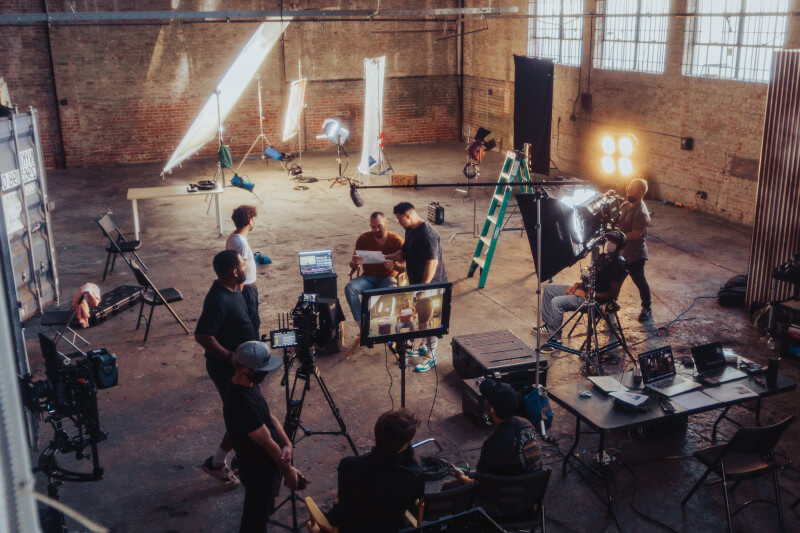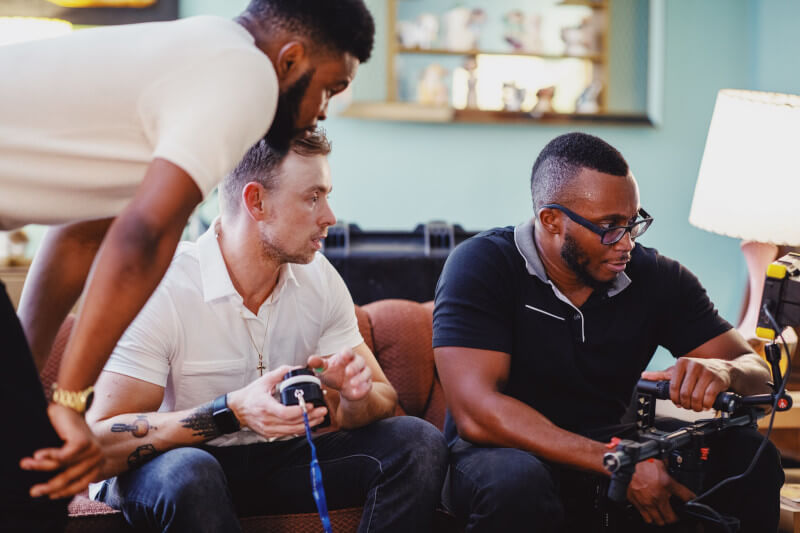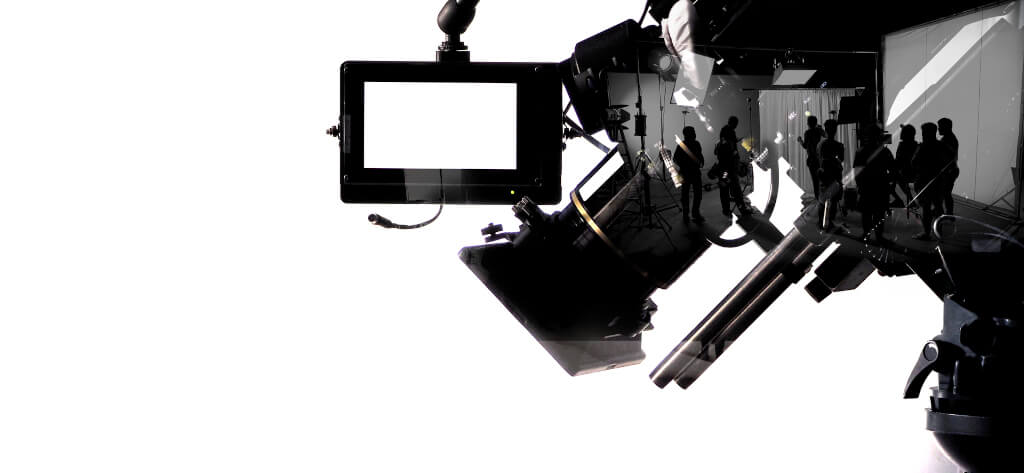Finding one’s way around the complex world of film and TV production is a lot like conducting a symphony. It’s a carefully orchestrated dance in which everyone has their place and everyone is working together towards a common goal: the creation of something new. When making a movie, the cast and crew don’t have the luxury of practising together beforehand like a symphony orchestra does before the conductor (the director) announces “action.” That’s why you must learn and adhere to proper on-set etiquette.
Everyone on set, from the A-list performers to the runners, is expected to abide by a set of unspoken conventions and codes of conduct that have developed over the years. Having everyone on the team on the same page with these ‘rules of engagement’ is crucial to maintaining peace and improving everyone’s work performance. If you’re new to the business or just want to brush up on your skills, this thorough guide on managing behaviour on set will teach you all you need to know about acting professionally, acknowledging authority, speaking clearly, putting safety first, and creating a fun, productive environment.
Soon, you’ll find sections dedicated to specific aspects of the set protocol, each with helpful tips for making your next production go off without a hitch. So, whether you’re a seasoned pro or an enthusiastic newcomer, come along as we walk you through this crucial primer on proper behaviour on set. Okay, so let’s begin!
Etiquette Fundamentals for the Film Set

Definitions of Some Crucial Words in the Language of Set Manners
It’s important to get a handle on a few basic terms before going into the meat of set etiquette. A film or television set is full of specialised jargon and colloquialisms that, to the inexperienced, may as well be a foreign language.
The ‘Call Sheet’ is a document handed out to the actors and crew the night before a shoot that specifies the day’s events, including but not limited to:
- Location, transportation, contact numbers, and scene breakdowns.
- “Call Time” means that you must be on set and ready to begin work at the specified hour.
- The term “Craft Services” is shorthand for the division in charge of on-set catering.
- When they are not needed on set, actors wait in what is known as “the green room.”
- “Hot Set” refers to a location where shooting is currently taking place.
- “Blocking” refers to the director’s practice of deciding where the performers will move and stand during a scene.
- The phrase “Quiet on Set” is spoken as the cameras are about to roll to signal silence on the set.
Respect and Professionalism on Set Respect
Professionalism is essential in every job, and that includes a film or television set. Everyone involved, from the director to the grip, contributes to the final product. Therefore, everyone’s actions affect the mood, productivity, and success of the production as a whole.
First and foremost, being on time is mandatory. A single delay in arrival time might throw off the entire day’s plans, leading to more work and expense. Always check in with the office to confirm your call time, and plan to come a few minutes early.
Second, know what you’re supposed to be doing and do it as well as you can. Think of yourself as a cog in the wheel of a broader team, each member of which is essential to the project’s completion. Maintaining professionalism necessitates an attitude of gratitude for everyone’s efforts.
Finally, it’s crucial to be discreet and mindful of people’s personal space. Sets are frequently locations where either sensitive material or prominent actors are present during filming. Do not talk about what you experience on set with your friends or on social media.
Getting Ready For The Set
Being on set is more than just showing up; you also need to be psychologically prepared, aware of your role, and dressed appropriately. These factors significantly affect the course of your workday and help you get things done.
Timeliness Is Very Important
The classic saying, “Time is money,” is especially pertinent in the film and television industries. A delay of even one minute might cause further problems and cost money. To be on time is to value the production schedule, the time of the cast and crew, and the budget.
Being on time is only part of what it means to be punctual. That includes being at the office ready to begin work at the allotted call time. Being prepared means both physically and psychologically ready to take on the day’s tasks. This level of professionalism not only earns the respect of one’s coworkers but also makes for a more pleasant and stress-free day at the office.
Realising Who You Are and What You Should Do

Contributing to a smoothly run set requires a solid understanding of one’s assigned duties. Make sure you know what your position entails and what is expected of you before you show up to set.
Clarity of role contributes to efficiency on set, whether you’re an actor who knows their lines, a makeup artist who knows the looks to be made, or a camera operator who knows the pictures to be taken. Before the shoot, feel free to clarify anything regarding your role that has you stumped. There is no better working crew than an informed one.
Adequate Appearance and Dress Code
Proper dress plays a significant role in preserving on-set decorum. What you wear is typically determined by your job description. Crew members, for example, should choose clothes that are functional and comfortable, given the long hours and physical nature of the work. Because of the frequent need to stand and walk around, flat shoes are strongly suggested.
Everyone who appears on camera will have access to their costumes in advance. If you’re expected to dress yourself for a role, choose pieces that suit your character and the context of the scenario.
Personal cleanliness is an integral part of the presentation. Keep in mind that a set is a communal, often close-quarters location. If you want to be respected by your coworkers, you need to portray yourself professionally.
Recognising and Honouring Authority on Set
Finding one’s way through the intricate social fabric of a film set is not always easy. Every position serves a purpose, and the whole is designed to make the workplace run smoothly and with harmony. Professionalism is encouraged and productivity is increased when everyone on set knows their place and treats each other with due respect.
Clarification of the Rank Structure of Set Roles
On a film set, the chain of command resembles a pyramid. The Director sits atop the production team and is in charge of all artistic decisions. Assistant Directors help out with things like planning and coordinating. The DP is in charge of the camera and lighting department, while the PD is responsible for the set and props.
Other important responsibilities, each with its staff, support these upper-level positions. A Sound Mixer, Boom Operator, and even a Sound Assistant might be found working in the sound department. Similarly, a Set Designer, Prop Master, and Art Assistant can make up the art department.
The structure of the hierarchy provides for the systematic assignment of duties, the maintenance of open lines of communication, and the identification of those with ultimate decision-making authority. Finding your place in the organisational chart and learning who you report to is crucial.
Relationship Building with the Cast and Crew: From Directors to PAs
Clear, polite communication is key to navigating the hierarchical nature of a film set. Keep in mind that communicating with the appropriate person is essential. The Director or the Assistant Director is usually the first person an actor talks to on set, rather than the camera operator or the sound technician.
The Director should not be approached with questions or concerns by Production Assistants, who are typically at the bottom of the hierarchy, but rather by the Production Coordinator or the Assistant Director.
This streamlined process for communication lessens the likelihood of misunderstandings, keeps lines of authority clear, and guarantees that everyone can concentrate on their assigned tasks without being distracted.
Recognising the Value in Each Person’s Contribution
On a film set, everyone’s contribution is essential. Everyone’s work, from the Director down to the Production Assistants, is crucial to the completion of the production. Recognising the value of others requires understanding the contributions of each individual and giving them the room they need to do their jobs.
This deference includes not acting inappropriately in your assigned position. If you’re a Grip and you start making ideas for the script or if you’re an actor and you start fiddling with the lights, you’re interrupting the workflow and getting in the way of the people whose jobs it is to do those things.
Everyone’s productivity, happiness, and comfort on set improve when everyone is aware of and follows the established chain of command. No matter how high or low on the totem pole a position may be, everyone plays an essential part in realising a goal.
Maintaining Order With Effective Communication
A well-organized set is built on the foundation of good communication. Communicating in a clear, succinct, and courteous manner improves understanding, speeds up task completion, and keeps the office environment pleasant for everyone. The creation of films and television is a high-stakes, high-speed industry where effective communication is crucial.
The Value of Polite and Effective Interaction
On a movie set, every word counts. Clear communication keeps everyone in sync and projects on track, from the Director’s directions to the smallest update from a Production Assistant. Mistakes lost time, and tensions all rise in direct proportion to the clarity of communication.
Conversely, a culture of trust and understanding can flourish when people communicate with one another with respect. Everyone, regardless of rank, is more inclined to give their all when they believe their contributions are being acknowledged and valued. The potential for unproductive misunderstandings or disputes is reduced when people are treated courteously.
How to Communicate Better on Set

On-set, the golden rule of communication is succinctness. Due to the time-sensitive nature of production, information must be conveyed as briefly and clearly as possible. Stay away from jargon unless it’s standard on-set parlance, and make sure your point has been grasped before moving on.
Next, make sure you’re communicating through the right channels. In most cases, it is preferable to contact a coworker from another division through their immediate supervisor.
Communication is not limited to words alone. Keep in mind that actions speak louder than words, and focus on how the other person is behaving rather than what they are saying. Showing up early and prepared, for instance, communicates dedication and professionalism.
Smartly employ technology. Walkie-talkies and other forms of on-set communication should be utilised to improve efficiency and mutual understanding, not to disrupt the process with background chatter.
Dealing with Conflict and Difficult Conversations
In a film set, when many people are working together, disagreements are inevitable. The way they are dealt with, though, is crucial. Some advice on how to handle challenging conversations:
Take immediate action
Leaving disagreements unresolved can cause further complications. Disagreements should be discussed as soon as possible.
Keep your cool and be courteous
Keep your cool even if tensions are high. Always keep in mind that de-escalation is preferable to settlement. Disagreements can be avoided by taking the time to listen and empathise with the other party. Before answering, try to put yourself in the other person’s shoes.
If mediation is needed, do it
Bring in a higher-up or a neutral third party to mediate if you can’t get to the bottom of things on your own.
Keeping a Proper and Upbeat Professional Attitude
Keeping your cool on a busy set is just as important as perfecting your performance. How you carry yourself can have a significant impact on the mood and spirit of the whole team. This means that you can’t afford to lose your cool and must always act professionally and with patience.
Understanding the Value of Optimism and Patience
The unexpected nature of film sets. Expect the unexpected at every turn, from scheduling changes to last-minute reshoots. Maintaining a positive attitude and encouraging resilience in the face of adversity are two benefits that come from practising patience. When combined with optimism, patience can spark the kind of creative problem-solving that propels production.
Managing Stress and Resolving Conflict
Disputes and arguments are more likely to occur in high-stress settings. It is possible to maintain emotional stability by the practice of stress management strategies such as deep breathing, mindfulness, or even just going for a short walk. Active listening, open-mindedness, and constructive feedback are all useful conflict resolution strategies to keep in mind.
Promoting an Atmosphere of Mutual Help and Cooperation
Each person may flourish and the whole group can achieve more in an atmosphere of mutual support and cooperation. Recognise and reward good performance, offer assistance when asked, and promote honest dialogue. As a result of your efforts, everyone will have a more positive and fruitful time at work.
Final Thoughts
Behaving professionally throughout the shoot extends to the final stages as well. This will demonstrate your competence and ensure a seamless transition into post-production.
Closing Out Your Scene Properly at the End of Filming is Crucial
There are duties associated with every position on a film set. Everything from breaking down the set to saving digital data and returning rental gear requires prompt and conscientious attention to detail. Your professionalism will shine through and the manufacturing process will benefit from your careful attention to detail if you take on these responsibilities.
How to Properly End a Performance When Filming Is Finished
It takes finesse to exit a set in the right way. It’s crucial to keep track of everything you’re supposed to do, return any borrowed materials, and properly dispose of any trash. Say your thanks to your coworkers and bosses, but don’t leave until you’ve been permitted to do so.
